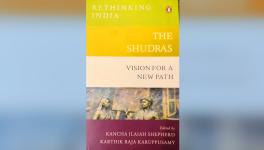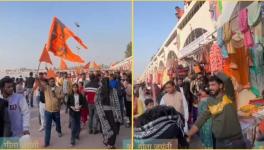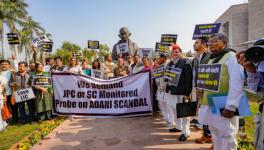Politics Over Hate Speech Ban in Karnataka
File Image
In its manifesto for the Karnataka polls, the Congress party committed to ban organisations that “spread hatred against communities on grounds of religion or caste”. In that sense, it equated the Peoples Front of India, banned by the Bharatiya Janata Party government at the Centre, with the Bajrang Dal, an offshoot of the Vishwa Hindu Parishad, itself an arm of the Rashtriya Swayamsevak Sangh, of which the BJP is an arm.
There was a mini-storm in response, as the BJP made it a major issue in the last days of its election campaign. The Congress manifesto gave the BJP the chance to discuss its favourite election plank—its ranks immediately equated Hanuman, also known as Bajrang Bali, with the Bajrang Dal, which borrows its name from the Hindu deity, while Prime Minister Narendra Modi made two claims—both of which need to be proven—that the Congress was trying to lock up lord Hanuman, and that this was ‘just like when it had locked up Lord Rama’. Of course, the BJP regularly brings up the Hindu deity Rama and claims credit for the temple dedicated to him coming up in Ayodhya in its election campaigns.
The Congress party retaliated that equating lord Hanuman with the Bajrang Dal insults the revered deity, and that the BJP is hurting Hindu sentiments with the comparison. It said the BJP banned—the Sri Ram Sene, an organisation in Goa that took the name of Lord Rama—so it should not cry itself hoarse over the Bajrang Dal.
Lord Hanuman, who symbolises devotion, is revered in many parts of India, and poet-saint Tulsidas wrote the Hanuman Chalisa, which is among the most popular hymns in India. But can the Bajrang Dal make itself synonymous with Bajrang Bali, or the powerful Hanuman, in any way? The Jai Bajrang Bali or Hail Hanuman slogan is often raised in the BJP’s public meetings, but it is with less faith and devotion and more aggression on display, for the aim is to polarise India’s two biggest religious communities for the sake of consolidating Hindu votes.
Regardless of the BJP’s intention, the important question is, can those who have sworn by the Constitution invoke gods and goddesses in their public meetings? And why, if it can, does the BJP oppose members of other faiths, or activists or politicians, who also raise religious slogans in political contexts—slogans such as Allah-u-Akbar or God is great?
Recall that the Bajrang Dal is an offshoot of the VHP, which came into prominence in the 1980s when it vociferously demanded the construction of a temple dedicated to Lord Rama at the site where the Babri masjid once stood in Uttar Pradesh. It was formed to involve contemporary youth in the divisive campaign, and it spread across many parts of the country. It was instrumental in recruiting youth for so-called kar seva, or religious service, but it eventually ended in the demolition of a mosque built in 1527, when the Mughal ruler Babur ruled over Hindustan.
The demolition of the Babri mosque was a dark chapter in India’s history, and the Bajrang Dal’s creed of violence was visible in it. Its ‘volunteers’ offered the BJP’s top leader in those days, LK Advani, a cup of their blood and a tilak of blood during his Ram-Janaki Rath Yatra (or procession), which spread violence and unrest in its wake. The cult of violence was an inherent part of its programs.
Vinay Katiyar, the chief of the Bajrang Dal and former Rajya Sabha Member of Parliament, said on the eve of the demolition of the Babri mosque that its debris would be thrown into the river Sarayu flowing through Ayodhya. That demolition led to widespread violence, and was not just the spark for the Bombay riots in India, but sparked attacks by fundamentalists in other countries against the minority Hindu residents.
One issue the Bajrang Dal has regularly raked up—prompted by its primitive notions about modernity and tradition—is the celebration of Valentine’s Day by young couples. They are known to illegally attack, mob and apprehend couples on this day, and thrash them in parks and restaurants. It has even ‘opposed’ women and girls wearing jeans and came up with a dress code for females.
Roman Catholic priest Graham Steward Stains’ burning along with his young son, which former President KR Narayanan called a “monumental aberration of time-tested tolerance and harmony” that belongs to the world’s inventory of black deeds”, was also done by Bajrang Dal members. Initially, then home minister Advani had denied the Bajrang Dal was involved in this gruesome crime, but investigations pointed the finger to Rajendra Pal “Dara Singh”, a member of the Bajrang Dal. He is currently serving life imprisonment.
There were many incidents between 2006 to 2008 that highlighted the warped priorities and violent actions of Bajrang Dal “activists”. For example, Naresh and Himanshu Panse (a VHP member), were accidentally killed while making bombs, and a kurta-pyjama and a false beard were found near the site. It hinted that the attempt was to pin a blast on to a Muslim perpetrator, and, by extension, create an opportunity to blame the entire Muslim community for the damage it would cause. There have been other such instances, where the finger of suspicion has come to rest on a member of the right-wing brigade, though more often than not, the role is denied by the Bajrang Dal. In January 2019, another worker of the outfit, Yogesh Raj, was arrested for the murder of inspector Subodh Kumar in Bulandshahr, Uttar Pradesh. The incident involved allegations of a cow having been slaughtered. In the recent Ram Navami violence in Bihar Sharif, Kundan Kumar, also of the Bajrang Dal, has been arrested for fomenting unrest and violence.
What about the PFI? Spreading hate and consequent violence has been the hallmark of their activities, too. Such organisations may operate in the name of religion but are intolerant and resort to violence. On an earlier occasion, Congress leader Rahul Gandhi compared the RSS with the Muslim Brotherhood in Egypt, saying, “The RSS is trying to change the nature of India. There is no other organisation in India that wants to capture India’s institutions... It is similar to the idea that exists in the Arab world of the Muslim Brotherhood. The idea is that one ideology should run through every institution and one idea should crush all other ideas.” The Muslim Brotherhood was banned after Egypt’s president Anwar Sadat was assassinated—and the RSS was banned after Mahatma Gandhi’s assassination. Rahul Gandhi said the “most interesting” comparison between the two outfits is that neither allows women members. What also puts them in the same league is they oppose liberty, equality, and fraternity.
Religiosity has intensified in India in the last few decades, as has politics in the name of religion. As society shifts towards orthodoxy, even secular parties are afraid to criticise communal forces that use religion as an instrument to capture or retain power. One can only remind them that the Taliban’s dictates for women may sound terrible, but oppression, even when measured in degrees, causes suffering and torment—opposing jeans for women and imposing the burqa are on the same spectrum of tyranny, even if the degrees vary.
The author is a human rights activist and taught at IIT Bombay. The views are personal.
Get the latest reports & analysis with people's perspective on Protests, movements & deep analytical videos, discussions of the current affairs in your Telegram app. Subscribe to NewsClick's Telegram channel & get Real-Time updates on stories, as they get published on our website.
























